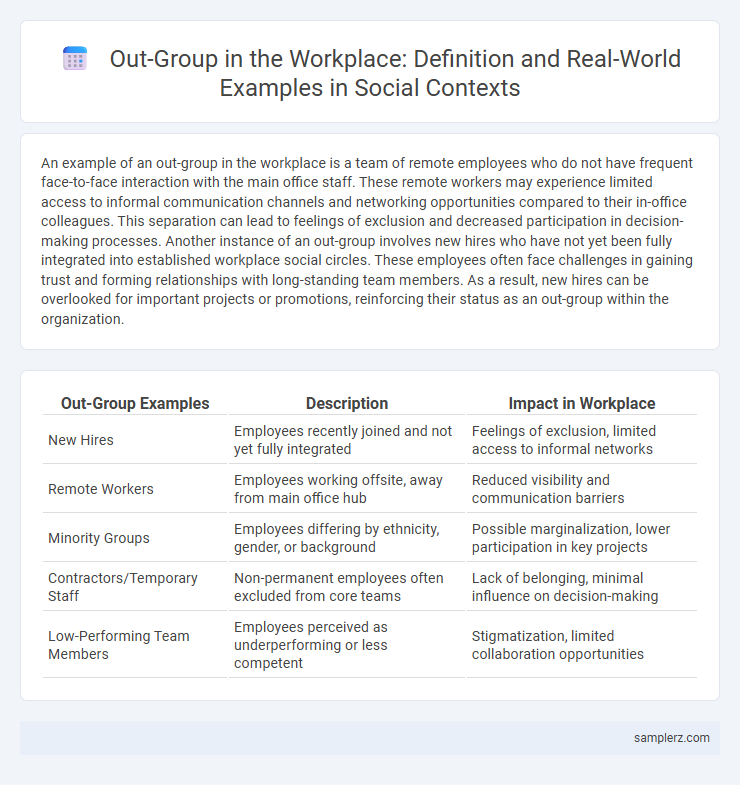An example of an out-group in the workplace is a team of remote employees who do not have frequent face-to-face interaction with the main office staff. These remote workers may experience limited access to informal communication channels and networking opportunities compared to their in-office colleagues. This separation can lead to feelings of exclusion and decreased participation in decision-making processes. Another instance of an out-group involves new hires who have not yet been fully integrated into established workplace social circles. These employees often face challenges in gaining trust and forming relationships with long-standing team members. As a result, new hires can be overlooked for important projects or promotions, reinforcing their status as an out-group within the organization.
Table of Comparison
| Out-Group Examples | Description | Impact in Workplace |
|---|---|---|
| New Hires | Employees recently joined and not yet fully integrated | Feelings of exclusion, limited access to informal networks |
| Remote Workers | Employees working offsite, away from main office hub | Reduced visibility and communication barriers |
| Minority Groups | Employees differing by ethnicity, gender, or background | Possible marginalization, lower participation in key projects |
| Contractors/Temporary Staff | Non-permanent employees often excluded from core teams | Lack of belonging, minimal influence on decision-making |
| Low-Performing Team Members | Employees perceived as underperforming or less competent | Stigmatization, limited collaboration opportunities |
Defining Out-Groups in the Workplace
Out-groups in the workplace refer to employees or teams who are excluded or marginalized from the dominant in-group, often resulting in limited access to resources, information, and organizational support. These out-groups may include new hires, minority employees, or remote workers who experience reduced social integration and lower influence in decision-making processes. Recognizing and addressing out-group dynamics is essential for fostering inclusive workplace cultures and enhancing overall team collaboration and productivity.
Characteristics of Workplace Out-Groups
Workplace out-groups often consist of employees who are marginalized due to differences in job roles, social cliques, or perceived lower status, leading to exclusion from key communications and decision-making processes. These groups typically experience limited access to resources, lack of recognition, and diminished opportunities for career advancement. The resulting social isolation can negatively impact motivation, engagement, and overall productivity within the organization.
Causes of Out-Group Formation at Work
Out-group formation in the workplace often results from perceived differences in values, goals, or work styles between teams or individuals. Social identity theory explains that employees tend to favor in-groups while marginalizing those who do not share common characteristics or status. Organizational structures that promote competition over collaboration further exacerbate out-group biases by limiting opportunities for positive intergroup interactions.
Common Examples of Out-Groups in Offices
Out-groups in offices often include remote workers who are physically separated from on-site teams, leading to reduced social interactions and communication barriers. Temporary employees or contractors may also form out-groups due to limited access to company resources and exclusion from informal networks. Additionally, individuals from diverse cultural backgrounds can experience out-group status when workplace norms and communication styles favor the majority group.
Impact of Out-Groups on Organizational Culture
Out-groups in the workplace, such as marginalized departments or employees excluded from core projects, can significantly impact organizational culture by fostering feelings of alienation and reducing overall team cohesion. This exclusion often leads to decreased motivation and lower productivity, creating a divide that hampers effective communication and collaboration across teams. Addressing the challenges posed by out-groups is essential for cultivating an inclusive culture that supports innovation and employee engagement.
Out-Groups Based on Job Roles and Hierarchy
Out-groups in the workplace often form due to job roles and hierarchical differences, such as lower-level employees or temporary staff feeling excluded by upper management or specialized professionals. These divisions can create barriers to communication and collaboration, reducing overall team cohesion and productivity. Understanding the dynamics of role-based out-groups is essential for fostering inclusivity and equal participation across all organizational levels.
Social Isolation: Out-Group Dynamics Among Colleagues
Social isolation in the workplace often manifests through out-group dynamics where certain colleagues are excluded from team interactions and decision-making processes. Employees who differ in cultural background, job role, or communication style may form or be assigned to these out-groups, leading to reduced collaboration and morale. This segregation can hinder productivity and workplace cohesion by limiting diverse perspectives and fostering feelings of alienation among isolated individuals.
How Out-Groups Affect Team Collaboration
Out-groups in the workplace, such as employees who are excluded from core project teams or social networks, often experience reduced communication and trust with in-group members. This division can lead to decreased knowledge sharing, hindering overall team collaboration and innovation. Research shows that these social boundaries negatively impact team cohesion, resulting in lower productivity and job satisfaction.
Addressing Bias and Stereotyping in Workplace Out-Groups
Workplace out-groups often consist of employees who differ from the dominant group in aspects such as race, gender, or job role, leading to bias and stereotyping. Addressing these challenges requires implementing inclusive policies, diversity training, and open communication channels to foster mutual respect and understanding. Companies that actively reduce bias improve team cohesion, employee satisfaction, and overall organizational performance.
Strategies for Bridging the Out-Group Divide at Work
Employees excluded from core project teams often represent the out-group in the workplace, leading to decreased collaboration and morale. Implementing mentorship programs and cross-functional team initiatives fosters inclusion and enhances communication between in-group and out-group members. Regular feedback sessions and diversity training further bridge the divide, promoting a cohesive organizational culture.

example of out-group in workplace Infographic
 samplerz.com
samplerz.com